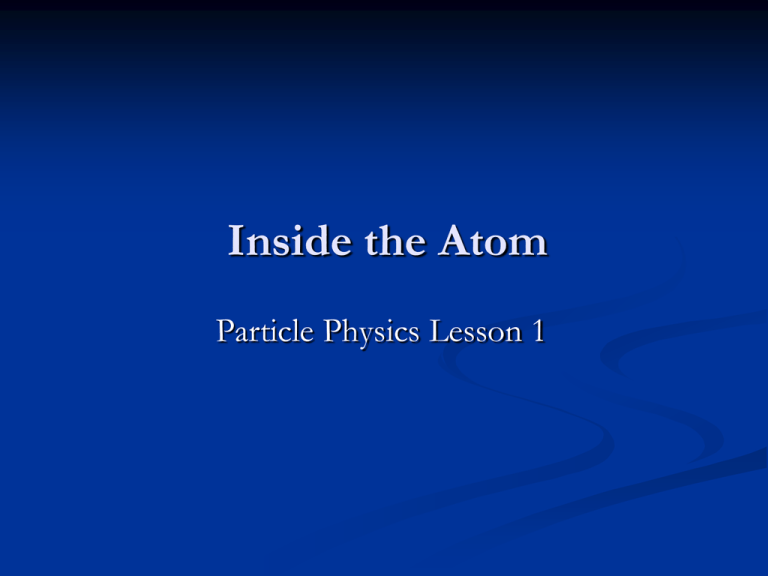The quest to understand the ultimate particle within the atom has been a cornerstone of modern physics. At the outset of this inquiry, one must appreciate that the atom, once considered an indivisible entity, is, in truth, a complex conglomerate of subatomic particles. As our understanding has evolved, so too have our conceptions of what constitutes the “ultimate particle.” This discourse will delve into the myriad constituents of the atom, the prevalent model of atomic structure, and the prevailing theories regarding fundamental particles, culminating in the examination of quarks as the constituent of protons and neutrons.
Historically, the notion of the atom emerged from ancient philosophical musings, notably by thinkers such as Democritus, who posited that matter was composed of indivisible particles. However, the advent of modern science ushered in an era during which atoms were dissected, revealing that they reside within a broader framework of subatomic particles: protons, neutrons, and electrons. At the core of this intricate structure lies the atomic nucleus, which is composed of protons and neutrons, while electrons orbit around this nucleus within specified energy levels.
Protons are positively charged particles that possess a relatively large mass when compared to electrons, which bear a negative charge and are significantly less massive. Neutrons, on the other hand, carry no charge and possess a mass akin to that of protons. The interplay between these particles gives rise to the unique characteristics of elements, with the atomic number — defined as the number of protons in the nucleus — dictating the identity of the element itself.
Despite the well-established understanding of these components, the inquiry into the “ultimate particle” extends beyond these familiar entities. In the pursuit of a deeper comprehension, one encounters the concept of fundamental particles. Defined by the Standard Model of particle physics, these fundamental particles are the building blocks that comprise all matter and the forces that govern their interactions. The Standard Model identifies two main categories of fundamental particles: fermions, which constitute matter, and bosons, which mediate interactions between particles.
Fermions are further subdivided into quarks and leptons. Quarks are particularly noteworthy because they combine in various configurations to form protons and neutrons, while leptons represent particles like electrons. Quarks themselves are characterized by six “flavors” — up, down, charm, strange, top, and bottom. Within the context of standard atomic structure, up and down quarks combine to form protons and neutrons; specifically, a proton consists of two up quarks and one down quark, while a neutron comprises one up quark and two down quarks. This composition is pivotal not only in defining the structure of atomic nuclei but also in elucidating how these particles behave under diverse conditions.
To comprehend the intricacies of quarks, one must also consider the forces acting upon them. The strong force, mediated by particles known as gluons, binds quarks together within protons and neutrons. This force is exceedingly powerful at diminutive distances, confining quarks in a manner that ensures they do not exist independently; rather, they are perpetually sequestered within baryons (such as protons and neutrons) or mesons (which consist of a quark-antiquark pair).
The exploration of these ultimate particles further extends to the arena of theoretical physics, where inquiries into supersymmetry and string theory prompt speculation about additional dimensions of matter and energy. Supersymmetry proposes the existence of superpartners for all known particles, while string theory posits that the fundamental constituents of the universe may not be point-like particles but rather one-dimensional strings, vibrating in multiple dimensions. If substantiated, these theories may revolutionize our understanding of the ultimate nature of matter and its spatial-temporal characteristics.
Furthermore, the interplay between quantum mechanics and relativity introduces another layer of complexity to our understanding of atomic and subatomic particles. Quantum field theory, which amalgamates quantum mechanics with special relativity, elucidates how particles are excitations within underlying fields. In this context, the pursuit of the ultimate particle converges with questions regarding the fabric of spacetime itself, as understanding particle interactions necessitates grappling with the very geometry of the universe.
In summation, the inquiry into the ultimate particle within an atom reveals a tapestry of complexities involving quarks, gluons, leptons, and the fundamental forces that govern their interaction. The Standard Model provides a robust framework, though it is not without its limitations and unanswered questions. As researchers delve deeper into the microcosm of particle physics, the implications span far beyond the merely academic, influencing our foundational perceptions of the universe and the potentials that lie therein. Indeed, the pursuit of knowledge within this domain beckons the inquisitive to consider the very essence of existence, urging exploration into realms yet uncharted in the annals of human understanding.












